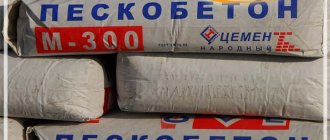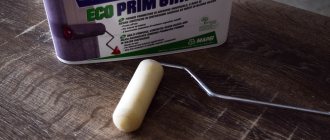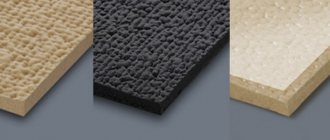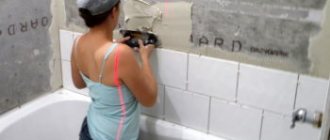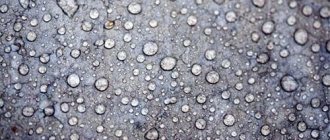Why do you need a primer for a concrete floor?
Figure 1. Primer mixture for concrete floors
Primer mixture for floors made of various grades of concrete is used to ensure:
- filling unevenness, roughness, small pores in concrete;
- creating a level base before applying the finishing leveling solution, as well as gluing the main floor covering;
- more reliable connection between the base and the floor covering.
- protection of the base from rapid destruction under the influence of moisture, from mechanical loads and damage.
Varieties
Polyurethane primer for concrete is divided into several subtypes, each of which has its own distinctive features. The following popular varieties with a polyurethane structure are distinguished:
- Acrylic mixtures. They belong to one-component compositions. They are usually used to treat surfaces made of MDF boards and wood. These impregnations have a deep-penetrating structure; they perfectly fill the wood base and level it. Acrylic mixtures are also often used for concrete surfaces indoors. They strengthen the material, making it more durable;
- Alkyd solutions. They are great for outdoor woodworking. They provide protection to the top layer from darkening. In order to make the wooden surface more expressive and bright, you can use priming enamels. It will be able to completely saturate the base and become the finishing coating;
- Epoxy paints or primers. This variety is excellent for treating metal surfaces and protects them from negative external influences. It can be used to protect concrete floors. The solution penetrates into small pores, levels the surface and makes it stronger;
- Primer concrete contact. Solutions of this type are often used for treating surfaces before laying tiles or for priming plasterboard sheets;
- Adhesive. After application, it creates a rough layer on the surface, which is of great importance for the full adhesion of materials to a smooth concrete surface.
Advantages and disadvantages
Like any building material, primer mixtures have certain pros and cons. Their advantages are as follows:
- have good adhesion to the base;
- have a high rate of spreadability over the main surface;
- form a durable, reliable, even coating;
- retain their technical properties under temperature changes;
- no sophisticated equipment is required (to prime a concrete floor, a small roller, a regular hand sprayer or a wide brush is enough)
The disadvantages of primers are their following features:
- certain types of soil contain substances that pose a potential danger to the environment and human health;
- long period of hardening of the primer layer.
Primer for aerated concrete: what are its differences
Aerated concrete, like foam concrete, are materials with a cellular structure. Despite the considerable advantages of such designs, some problems may arise during repairs. The main one is the water absorption coefficient is too high. We can say that aerated concrete actually absorbs liquid.
If you prime such a surface, the chances of water getting inside the material drop sharply. The composition will fill large pores very quickly and immediately clog them. It turns out that aerated concrete blocks will be covered with an almost invisible water-repellent film.
A special primer for aerated concrete can improve the thermal insulation properties of the material and reduce water absorption
But the blocks themselves will not become any worse:
- Their vapor permeability will not decrease;
- The thermal conductivity coefficient will even increase slightly (but you still can’t do without wall insulation).
Primers are an excellent material for repair work. They are odorless, easy to apply, and most importantly, they significantly strengthen the structure.
Types of primer for concrete floors
Based on their properties and scope of application, primer mixtures are divided into the following types:
- filling - applied to floors with a large number of small pores capable of absorbing moisture;
- adhesive (film-forming) - such compositions are used for priming relatively dense and non-moisture-absorbing substrates. By forming a continuous film of uniform thickness, they improve the adhesion of the finishing coating to the concrete screed.
- strengthening - compounds that, by filling the pores in the concrete base and covering it with a continuous film, increase its strength and resistance to mechanical loads;
- penetrating (deep penetration primers) - compositions that are used on dusty concrete floors. Due to their high penetrating ability, they are able to fill the deep pores of the base, thereby giving it additional strength and extending its service life.
According to the chemical composition, primer mixtures are alkyd, acrylic, epoxy, and polystyrene. Alkyd.
They contain alkyd polymers. The technical characteristics of such a primer mixture are as follows:
- retains properties in the temperature range from – 30. C to + 50 0 C;
- not afraid of exposure to aggressive environments (acids, alkalis);
- forms a durable surface that is resistant to abrasion.
Figure 2. Alkyd primer for concrete floors
Acrylic
It contains water and acrylic compounds. The main advantages of acrylic primer for concrete floors are its following features:
- reduces water absorption by porous substrates;
- provides good spreadability for subsequent application of leveling compounds (self-leveling or simple sand-cement screeds);
- after application to the surface it hardens quickly (3-4 hours);
- not afraid of the effects of alkali, high humidity;
- does not contain solvents, environmentally friendly.
Figure 3. Acrylic primer
The primer is not recommended for use in rooms with high humidity. The most popular acrylic primer is considered to be such a special composition as “Betonkontakt”.
Epoxy
The basis of this primer is epoxy resin and hardeners. The advantages of epoxy primer over analogues are as follows:
- retains properties at zero and negative temperature changes;
- creates additional protection of the base from mechanical damage;
- interacts perfectly with the final paint coating.
Figure 4. Epoxy primer for concrete
This material also has a drawback: a one-component epoxy primer for a concrete floor may not contain hardeners, which is why it will take time (more than 12 hours) for the layer to dry. The process of arranging the floor will have to be paused a little and wait. When choosing an epoxy primer for a concrete floor, these points should be taken into account.
Polystyrene
This primer mixture contains highly toxic solvents. It is used mainly for processing wooden bases of open buildings (terraces, gazebos). For concrete floors, this type of soil is used very rarely.
Other types of soils
Among other types of this material, the most common are the following primers:
- polyurethane - the most common primer mixture for concrete floors under paint and varnish;
- perchlorovinyl - the chemical composition of this soil contains many toxic components, so its scope is limited;
- a mineral mixture consisting of cement, lime, gypsum, used for priming concrete.
Technology of applying primer for self-leveling mixtures
First of all, you need to get rid of dirt on the subfloor. The concrete floor is cleaned dry, using a spatula to remove and scrape off all layers and dust remaining after pouring the screed. If the surface seems clean, then blow out all joints and crevices with compressed air. You should not wash or use water before applying a primer, even an acrylic one. Any remaining moisture can “raise” the self-leveling floor a couple of weeks after the layer has polymerized.
Apply the mixture to concrete
The soil is mixed with a mixer immediately before applying the material. There is no point in waiting for the bubbles to go away; they add additional plasticity to the mixture. Unlike a self-leveling floor, the soil is always liquid, so bubbles are easily squeezed out with the bristles of a brush or roller. The primer application scheme is similar to painting; it is necessary to accelerate the mixture, successively changing the direction of movement of the tool. Consumption will be 350-400 g/m2.
Important! If, after the primer has dried, cavities remain on the surface, then before the self-leveling floor you will need to apply a second layer, this time more viscous.
The second pass can be done as soon as the first layer has dried to the touch. The consumption for the second layer is 200-250 g/m2.
The priming process is similar to painting
Drying time
The stronger the soil, the longer it takes to dry. Epoxy and polyurethane, depending on the temperature, can dry up to two days, and if the room is below 12°C, it may not dry for a week.
At room temperature, the primer can dry faster than required by technology
Acrylic sets on average in 6 hours, so it is quite possible to make at least one layer of self-leveling floor in one working day. If the room is too dry or humid, the quality of adhesion of the primer coating decreases, so the time for forming the self-leveling floor must be chosen based on the manufacturer’s recommendations.
How to choose a primer for a concrete floor
The solution for concrete floors must ensure, first of all, their strengthening and leveling. Since concrete does not have a high degree of adhesion, the soil applied to the surface of the concrete base ensures its strong adhesion to the floor covering. These are general points to consider when choosing soils. There are also specific situations, for example, where and under what conditions the floor will be used, what kind of finishing coating.
The properties of adhesive (film-forming) strengthening primers make it possible to fully cope with such tasks.
To choose the right primer for a concrete floor with the most suitable properties and composition, we focus on the absorbency of the base. The surface of concrete floors is characterized by a low degree of absorption. Drops of water applied to concrete remain on the floor surface for 15-20 minutes.
Primer for concrete for exterior use: features
If you use a primer for external work, the set of qualities of this composition is quite strict.
If the primer is used for exterior use, it must be weather resistant
Primer for external work:
- Must be weather-resistant - in order to easily withstand the effects of precipitation and moisture, withstand temperature changes, as well as freezing cycles;
- The composition should contain preparations that will not allow fungi and bacteria to appear on the surface;
- The composition should also contain rust inhibitors and antioxidants, but this is if metal surfaces are involved in the repair;
- The external soil must contain more adhesive and film-forming components so that the base is strengthened as reliably as possible.
If you are going to putty and paint the surface in the future, it makes sense to purchase putty and paint of the same brand as the primer.
Composition and properties of primer for concrete floors
Primers for concrete are based on acrylic, polyurethane, epoxy components, quartz sand, and cement.
The main properties that all primers for concrete floors have are the following:
- uniform distribution over the surface of the concrete floor;
- high film strength of the primer mixture, comparable to that of the concrete base on which it is applied;
- durability of the primer layer - when applied correctly, the primer layer does not collapse and does not lose its performance properties for 50-80 years.
How and with what to apply primer to a concrete floor?
A layer of primer is applied to a clean, dry floor surface. The debris is removed, small cracks are puttied, oily areas are degreased. The solution is prepared strictly according to the instructions in compliance with the proportions indicated on the label. To apply the composition, use a special roller, brush, or spray bottle.
Important. When applying floor primer, be sure to wear a respirator, safety glasses, and gloves - the components contained in the composition pose a potential danger to the human body. When using epoxy primers that are diluted with organic solvents (acetone, white spirit), the room must have good natural or artificial ventilation.
What you need for a quality primer
Cleaning the wall is the first and main point of the preparatory part of the repair. All previous materials and old coating must be removed. Any cracks and depressions are subject to local repair. This is usually done using a deep penetration primer.
Next, you use either a simple primer for concrete, or prepare the base for painting using special mixtures.
High-quality preparation of the coating for priming is extremely important
If you want to solve the problem with pests that may appear at the same time, purchase a primer with an antiseptic; it is often used for external walls.
The solution itself, both for external and internal work, must be applied with a roller or brush, being sure to control the consumption. The packaging usually indicates how much this particular primer consumes per 1 m2. Do not add more composition, but do not try to save money, the quality will suffer as a result, strictly follow the instructions.
